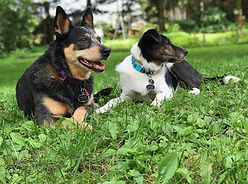
Animal Communication


Is It Really Possible to Communicate with Animals?
I get asked all the time, "How does animal communication work?"
If you are a pet owner, you probably realize our animals pick up and understand certain emotions, body language and words we say. Our animals are actually much more receptive than that. They are also able to receive and pick up the visual pictures in our head. The visual picture and the words together give them a more clear understanding of what we are trying to communicate.
So many times we tell our animals what we want and then visualize them behaving in an opposite manner. For example "DON'T JUMP" visualizing a jumping dog. Instead just using the word "DOWN" or "SIT," can create clear a communication and picture of what we want. If we as owners/parents/family are able to focus a little more on the pictures we visualize in our head specifically on what we want to happen instead of what we don't want to happen, there will be a clear understanding of what we are trying to communicate.
Animals communicate with each other through body language. Understanding an animal's body language is key to understanding behaviors. I have found that all species of animals have “calming signals.” These signals can give animal owners and professionals great insight into how our animals are feeling at any given moment.
Animals use body language to calm themselves or other animals in stressful situations, to show dominance, to communicate to us where they have pain in their body or to show us when they are confused or confident.


What Are Some Physical Animal Signals?
Physical signals are behaviors that animals do to communicate with each other and to release tension, stress or fear in their bodies. Understanding these signals as a human can help your understanding in a DRAMATIC way.

Calming Signals:
-
Blinking
-
Yawning
-
Sniffing the ground
-
Approaching in an arc
-
Shaking or holding up a paw
-
Sitting
-
Lying
-
Play bowing
Signals that Show Lack of
Calming Are:
-
Closing/clenching of the mouth
-
Staring
-
Leaning on the front paws
-
Stiff body posture- this often leads to aggression or intense fear
What Is an Animal Communication Session like?
During a pet communication session, I will ask you to write a list of questions or concerns on what you would like addressed. I will also need a picture of the animal. I will need you to communicate to your pet that they are allowed and encouraged to speak to me and that I am speaking to them to help the relationship between you and your pet, as well as their health and wellbeing.
First, I will communicate with them on my own and I will write down all that transpires with that interaction. I will work with your pet on many different levels to create a desired outcome. The next step will be to set up a phone session with you to go over the many different ways you can help your pet in the best way possible.
What Can Pet Communication Help with?
-
Neurological Issues
-
Separation Anxiety
-
Behavioral Problems
-
Health Issues
-
Allergy Issues
-
Grief
-
Fear
-
Withdrawal
-
Abandonment Issues
-
Preparing for New Arrivals or Departures
-
Separation
-
Babies
-
Rescue
-
Preparing an Animal for Surgery or Other Medical Interventions or Procedures, like Neutering or Spaying, and Helping Shorten Recovery Time
-
Training
-
Digestive Issues
-
Trauma Issues
-
Transitioning/ End of Life Preparation
-
Aggression Issues
-
Depression
-
Phobias
-
Neglect Issues
-
Adjust to Changing Family Dynamics
-
Divorce
-
Delivery and Postpartum Care for Mother and Child
-
Traveling Adjustments
Professional animal communicators are not going to analyze, diagnose or prescribe anything medically. We leave that to the vet and medical professionals. We can assist by relaying what your animal needs to say, how they are feeling, where they hurt, when the problem started, what is helping, what isn’t helping but is in fact making things worse, and much more.


